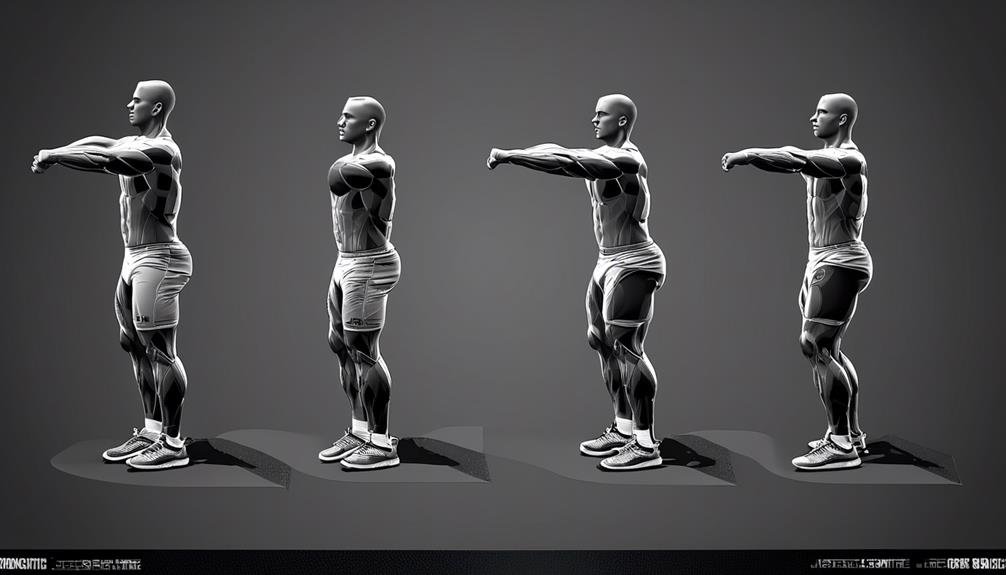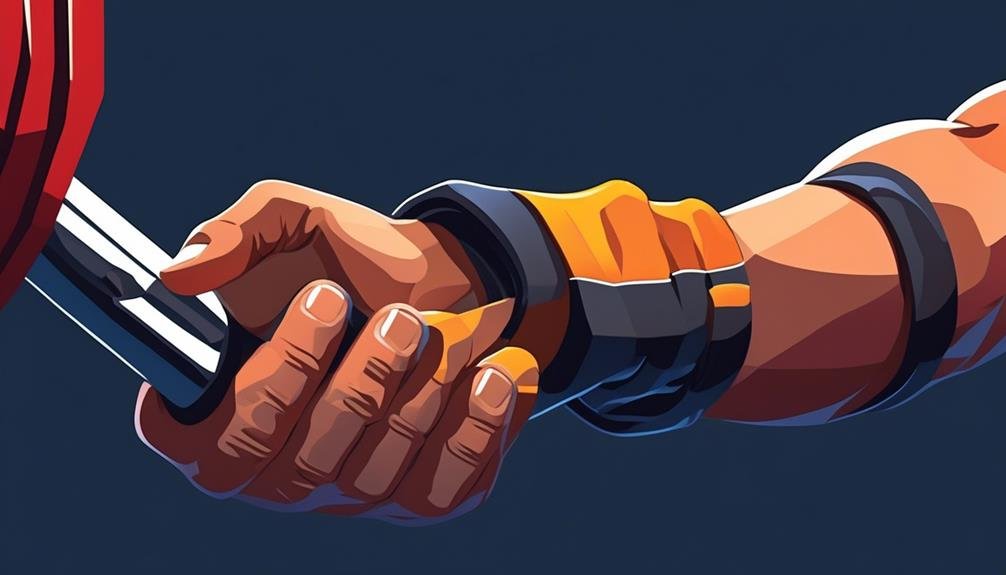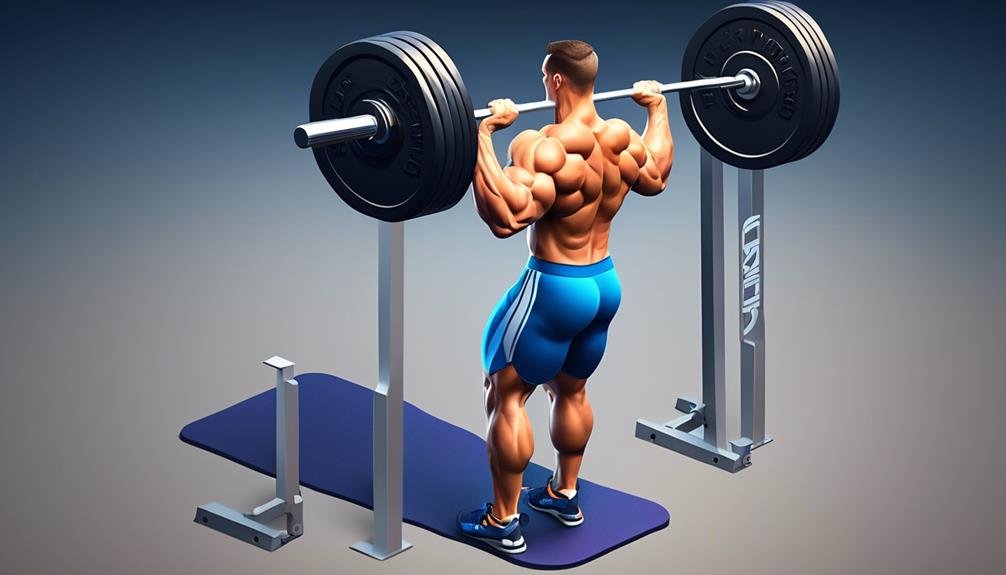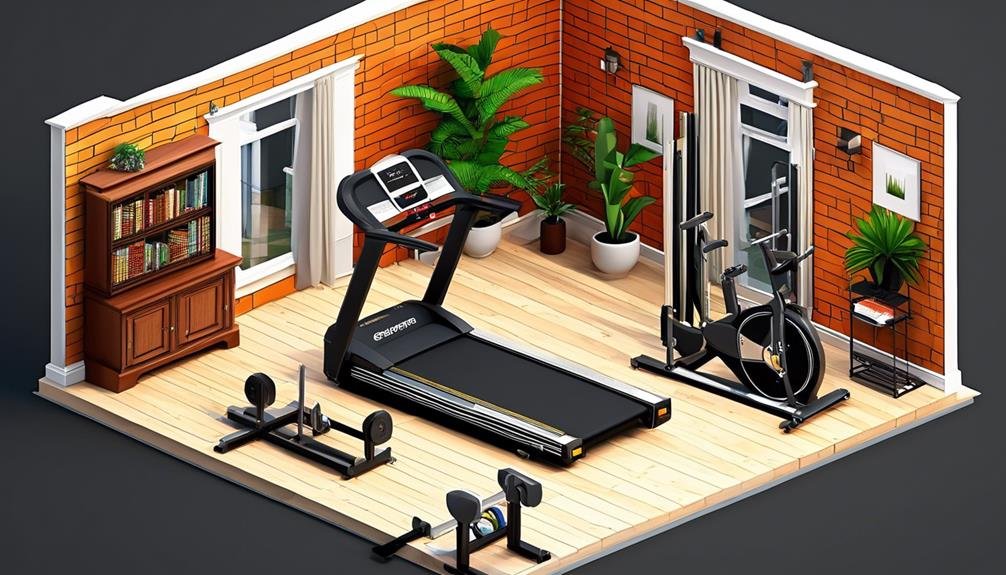Are you tired of feeling like your back is on the verge of snapping in half every time you attempt a deadlift? Well, fear not, because there is a way to safely perform this exercise without risking injury.
In fact, by following a few simple steps, you can not only protect your back but also maximize your strength gains and overall performance.
So, if you're ready to take your deadlift game to the next level and leave those back pains behind, keep on reading.
Key Takeaways
- Maintain proper form and technique to prevent strain and reduce the risk of injury.
- Focus on maintaining a neutral spine throughout the deadlift movement.
- Engage the posterior chain muscles, such as hamstrings and glutes, to primarily engage the legs and hips.
- Warm up properly, practice lighter weights with correct form, and gradually increase weight to prevent injuries and allow your body to adapt.
Importance of Proper Form
Proper form is crucial when deadlifting to ensure the safety and well-being of your back. By maintaining correct form, you can prevent unnecessary strain and reduce the risk of injury.
When performing a deadlift, start with your feet shoulder-width apart and grip the barbell with an overhand grip, hands slightly wider than your shoulders. Keep your back straight and engage your core muscles as you lower your hips and bend your knees, maintaining a neutral spine.
As you lift the weight, focus on driving through your heels and using the power of your legs, rather than relying solely on your back muscles. Keep the barbell close to your body throughout the movement and avoid excessive rounding or arching of your back.
Remember to breathe steadily and exhale as you lift the weight. By following these guidelines, you can safely deadlift without risking injury to your back.
Understanding the Deadlift Movement
To fully understand the deadlift movement, it's essential to grasp the biomechanics and muscle groups involved in this compound exercise. The deadlift is a powerful full-body exercise that primarily targets the muscles of the posterior chain, including the glutes, hamstrings, and lower back.
Here are five key points to help you understand the deadlift movement:
- Starting position: Begin with your feet hip-width apart, gripping the barbell just outside your legs. Keep your back straight and core engaged.
- Hip hinge: Initiate the movement by pushing your hips back while maintaining a slight bend in your knees. This engages the glutes and hamstrings.
- Bar path: As you lift the barbell, keep it close to your body, ensuring it travels in a straight line. This minimizes stress on your lower back.
- Full extension: At the top of the movement, fully extend your hips by squeezing your glutes. Maintain a neutral spine position.
- Lowering the weight: To complete the rep, lower the barbell back down in a controlled manner, maintaining a neutral spine and engaging your core.
Understanding these key aspects of the deadlift movement will help you perform the exercise correctly and minimize the risk of injury.
Preparing Your Body for Deadlifting

Before you start deadlifting, it is important to properly prepare your body. Taking the time to warm up and stretch can help prevent injuries and improve your performance. Here are some key steps to get your body ready for deadlifting:
| Step | Description |
|---|---|
| 1 | Warm up with cardio exercises like jogging or cycling for 5-10 minutes to increase blood flow and raise your body temperature. |
| 2 | Perform dynamic stretches that target the muscles used in deadlifting, such as hip circles, leg swings, and torso twists. These movements help improve mobility and activate the muscles. |
| 3 | Activate your core muscles with exercises like planks and bird dogs. A strong core provides stability and protects your lower back during the lift. |
| 4 | Practice proper form with lighter weights before moving on to heavier loads. This helps you reinforce correct movement patterns and reduces the risk of injury.
Core Stability and Deadlifting
To safely deadlift without injuring your back, it's crucial to develop core stability. Your core muscles, which include your abdominals, lower back, and glutes, play a vital role in providing support and stability during the deadlift movement.
Here are five key reasons why core stability is essential for safe deadlifting:
- Spinal Support: A strong core helps maintain proper alignment and stability of your spine, reducing the risk of back injuries.
- Force Transfer: Core stability allows for efficient transfer of force from your lower body to your upper body, enabling you to lift heavier weights.
- Balance and Control: A stable core helps you maintain balance and control throughout the deadlift, reducing the likelihood of falling or losing your grip.
- Injury Prevention: Developing core stability can prevent excessive strain on your back muscles and ligaments, reducing the risk of strains, sprains, and other injuries.
- Improved Performance: By strengthening your core, you can generate more power and stability during the deadlift, leading to improved performance and better overall results.
To enhance your core stability, incorporate exercises such as planks, Russian twists, and bird dogs into your training routine. Remember to focus on maintaining proper form and engaging your core muscles throughout each exercise.
Building a strong and stable core won't only protect your back but also enhance your deadlifting performance.
Proper Grip and Hand Placement

Developing a proper grip and hand placement is crucial for safely deadlifting without injuring your back. When it comes to deadlifting, the grip you choose and the placement of your hands on the barbell can significantly impact your performance and minimize the risk of injury. To help you understand the different options available and make an informed decision, let's take a closer look at the various grips and hand placements commonly used in deadlifting:
| Grip/Hand Placement | Description | Benefits |
|---|---|---|
| Overhand Grip | Both palms facing your body, hands shoulder-width apart or slightly wider. | Provides a secure grip and evenly distributes the load. |
| Mixed Grip | One palm facing your body, the other facing away, hands shoulder-width apart or slightly wider. | Increases grip strength and prevents the barbell from rolling out of your hands. |
| Hook Grip | Both palms facing your body, with your thumb wrapped around the bar and fingers over the thumb. | Offers a secure grip and reduces the risk of the barbell slipping. |
| Thumbless Grip | Both palms facing your body, without wrapping your thumbs around the bar. | Allows for a more natural hand position and reduces strain on the thumb. |
| Hand Placement | Hands positioned just outside your knees, shoulder-width apart or slightly wider. | Promotes a balanced and stable lifting position. |
Progression and Gradual Increase in Weight
To safely progress and avoid back injuries while deadlifting, it's important to gradually increase the weight you lift over time. Here are some key points to consider:
- Start with a weight that challenges you but allows you to maintain proper form. This weight should feel manageable, but not too easy.
- Once you have mastered the proper technique and can perform the exercise with ease, it's time to increase the weight. Aim for a 5-10% increase in weight for each workout.
- Listen to your body and pay attention to any signs of discomfort or pain. If you experience any issues, it may be a sign that you're progressing too quickly or using improper form.
- Consider incorporating other exercises into your training routine to strengthen the muscles involved in deadlifting, such as the glutes, hamstrings, and core.
- Keep a record of your progress, including the weight lifted and any modifications made to your technique. This will help you track your progress and identify any areas that need improvement.
Common Mistakes to Avoid

As you continue to progress in your deadlifting journey and gradually increase the weight, it's crucial to be aware of common mistakes that can lead to back injuries. By avoiding these errors, you can ensure a safe and effective deadlift workout.
One common mistake is rounding your back during the lift. This places excessive stress on your spine and increases the risk of injury. To prevent this, focus on maintaining a neutral spine throughout the movement.
Another mistake to avoid is lifting with your arms instead of your legs and hips. Deadlifting should primarily engage your posterior chain muscles, such as your hamstrings, glutes, and lower back. Engaging your arms too much can strain your back and limit the effectiveness of the exercise.
Additionally, rushing through the movement or using improper form can lead to injuries. Take your time to set up properly, maintain proper form throughout the lift, and avoid jerking or bouncing the weight.
Lastly, neglecting to properly warm up or using excessive weights too soon can increase the risk of injury. Prioritize a thorough warm-up and gradually progress in weight to give your body time to adapt.
Frequently Asked Questions
How Often Should I Deadlift to See Progress and Avoid Injury?
To see progress and avoid injury, deadlift 1-2 times per week. This frequency allows for adequate recovery while still providing enough stimulus for muscle growth and strength gains. Listen to your body and adjust accordingly.
Can Deadlifting Help Improve My Posture and Lower Back Pain?
Deadlifting can indeed help improve your posture and lower back pain. By strengthening your core and back muscles, deadlifts can promote better alignment and reduce discomfort. Start with proper form and gradually increase weight to avoid injury.
Is It Necessary to Wear a Weightlifting Belt While Deadlifting?
You don't have to wear a weightlifting belt while deadlifting, but it can provide extra support for your lower back. It's important to maintain proper form and gradually increase weight to prevent injuries.
What Should I Do if I Experience Lower Back Pain While Deadlifting?
If you experience lower back pain while deadlifting, it's important to stop and assess the cause. Check your form and technique, lower the weight if necessary, and consider seeking guidance from a qualified trainer or healthcare professional.
Are There Any Alternative Exercises That Can Provide Similar Benefits to Deadlifting?
You can try alternative exercises like hip thrusts, Romanian deadlifts, or trap bar deadlifts to work similar muscle groups and avoid back injuries. Always focus on maintaining good form and gradually increase weights.
Conclusion
In conclusion, to safely deadlift without injuring your back, it's crucial to prioritize proper form, understand the movement, and prepare your body adequately.
Maintain core stability, use a proper grip and hand placement, and gradually increase weight to avoid potential injuries.
By avoiding common mistakes and focusing on these key aspects, you can ensure a safe and effective deadlift workout.





